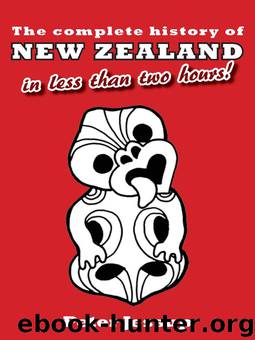The Complete History of New Zealand (in less than two hours) by Peter Jessup

Author:Peter Jessup [Jessup, Peter]
Language: eng
Format: epub
Tags: New Zealand History
Publisher: BookBaby
Published: 2013-05-14T12:00:00+00:00
Death and disasters
THE RELATIVELY small size of New Zealand’s population means that disasters have far–reaching effects in the community. It’s often said that every household has some connection to every major tragedy.
Significant events have included:
Worst death toll
The largest death toll from any incident in New Zealand’s history was the 8,573 who succumbed to the influenza epidemic of 1918.
Globally, more than 500 million were infected and 50 million were killed by the virus, which is believed to have evolved as an avian ‘flu which was passed from pigs to humans in much the same way more recent ‘bird ‘flu’ and ‘H1N1’ viruses mutated.
The virus was present in New Zealand for just three months, from October to December 1918.
Medical experts advised the cancellation of public events and the closure of hotels, billiard halls and other places where large groups met.
Streets were disinfected. Bases were set up where people were given a spray containing zinc sulphate which was believed to prevent infection — in fact it was medically useless.
In homes, sulphur was thrown on open fires in an attempt to fumigate the house.
Other remedies included a daily dose of quinine, or a teaspoon of sugar with a drop of kerosene. Lemon juice was supposed to be a preventive tonic and shops ran out of lemons.
Some communities were hardly touched, while others were devastated. Auckland city was hard hit, with medical workers unable to keep up with demand.
Bodies were carted in their hundreds by train to the suburb of Glen Eden, where they were laid out under trees awaiting burial because coffins could not be constructed quickly enough.
Studies since have traced the cause and effects of the epidemic and determined that the virus prompted an over–reaction of the body’s immune system, thus explaining why most of those killed were young adults to middle–age, rather than the very young or the elderly, who have weaker immune systems.
In the aftermath, the government passed the 1920 Health Act which put in place procedures for dealing with similar events, systems that remained in force until a revamp in 1956.
Natural disasters
In terms of loss of life, the worst natural disaster in New Zealand’s history was the Napier earthquake of 1931 in which 256 people lost their lives and much of the city was flattened.
The quake began at 10.47am on Tuesday, February 3, and it continued for two and a half minutes. Thousands were injured, and more than 400 were hospitalised.
Locals had noticed strange conditions beforehand — oppressive heat and humidity, still air and a sea that changed suddenly from flat calm to throwing huge waves onto beaches.
Birds were absent and other animals showed unusual signs of restlessness. For years afterwards, survivors talked of ‘earthquake weather’.
Minutes after the quake, fire broke out in a mainstreet Napier chemist shop and quickly spread through the centre of town. People trapped in rubble were burnt alive. Fire fighters had no means to tackle the blazes as water pipes had been broken.
The navy ship HMS Veronica was fortunately in port and its sailors provided immediate assistance in rescues.
Download
This site does not store any files on its server. We only index and link to content provided by other sites. Please contact the content providers to delete copyright contents if any and email us, we'll remove relevant links or contents immediately.
| Africa | Americas |
| Arctic & Antarctica | Asia |
| Australia & Oceania | Europe |
| Middle East | Russia |
| United States | World |
| Ancient Civilizations | Military |
| Historical Study & Educational Resources |
The Songlines by Bruce Chatwin(2110)
The Fatal Shore by Robert Hughes(991)
Origins to Eureka by Thomas Keneally(712)
11 The Bear And The Dragon by Tom Clancy(609)
A Commonwealth of Thieves: The Improbable Birth of Australia by Thomas Keneally(595)
Eureka to the Diggers by Thomas Keneally(578)
Australia 1901 - 2001 by Andrew Tink(572)
A Commonwealth of Thieves by Thomas Keneally(558)
Shoot Straight, You Bastards! by Nick Bleszynski(533)
Dark Emu by Bruce Pascoe(527)
The Penguin History of New Zealand by Michael King(496)
Carnivorous Nights: On the Trail of the Tasmanian Tiger by Margaret Mittelbach; Michael Crewdson; Alexis Rockman(491)
James Cook by Peter Fitzsimons(483)
The Book Of Ian Watson by Ian Watson(480)
Venom by Brendan James Murray(479)
The Tall Man by Chloe Hooper(423)
Murder on Easey Street by Helen Thomas(394)
The Golden Country by Tim Watts(389)
Australian History for Dummies by Alex McDermott(363)
